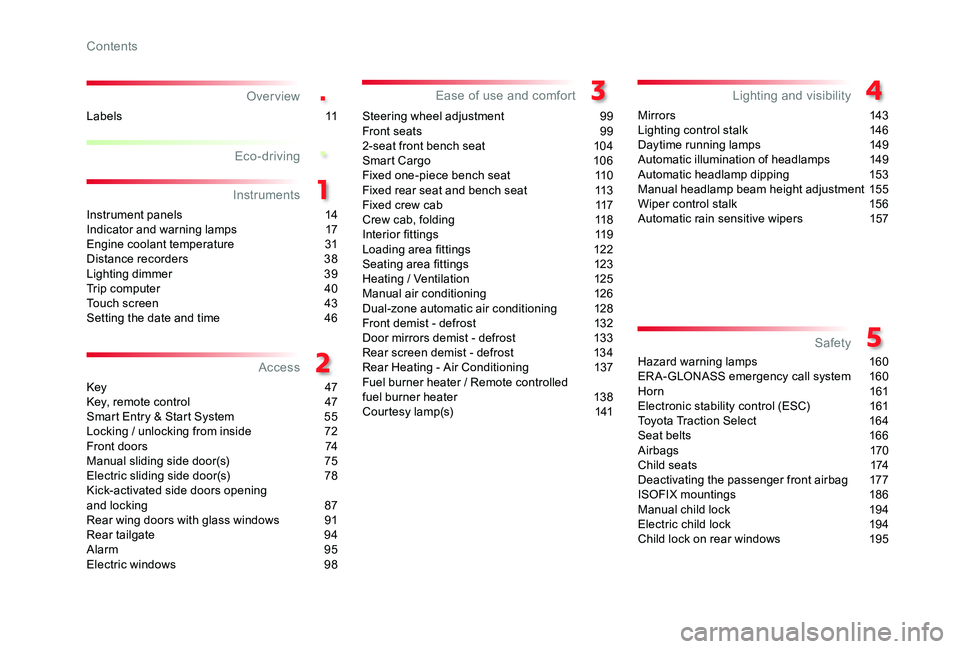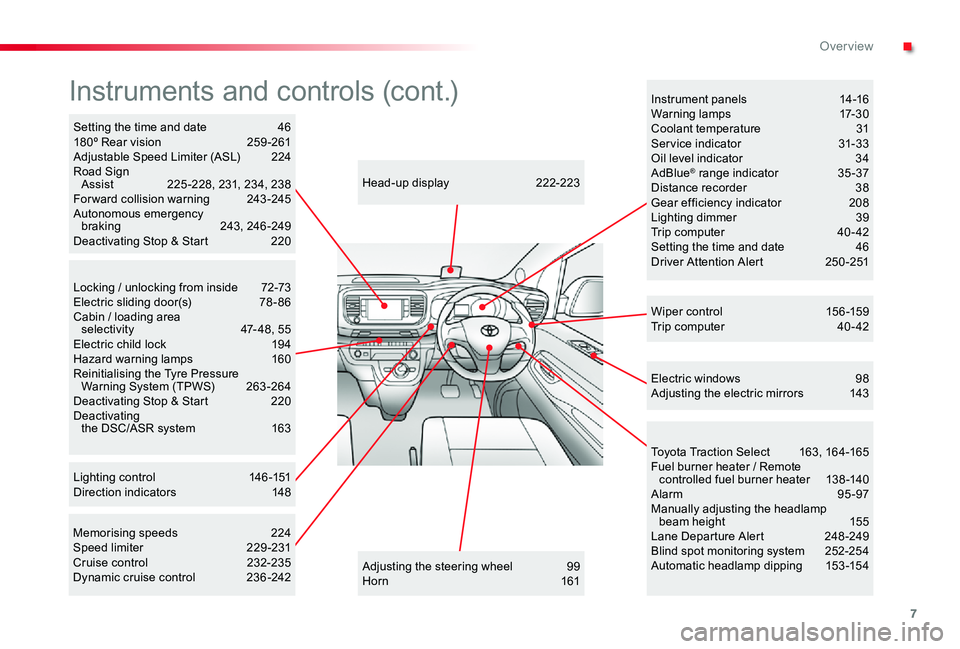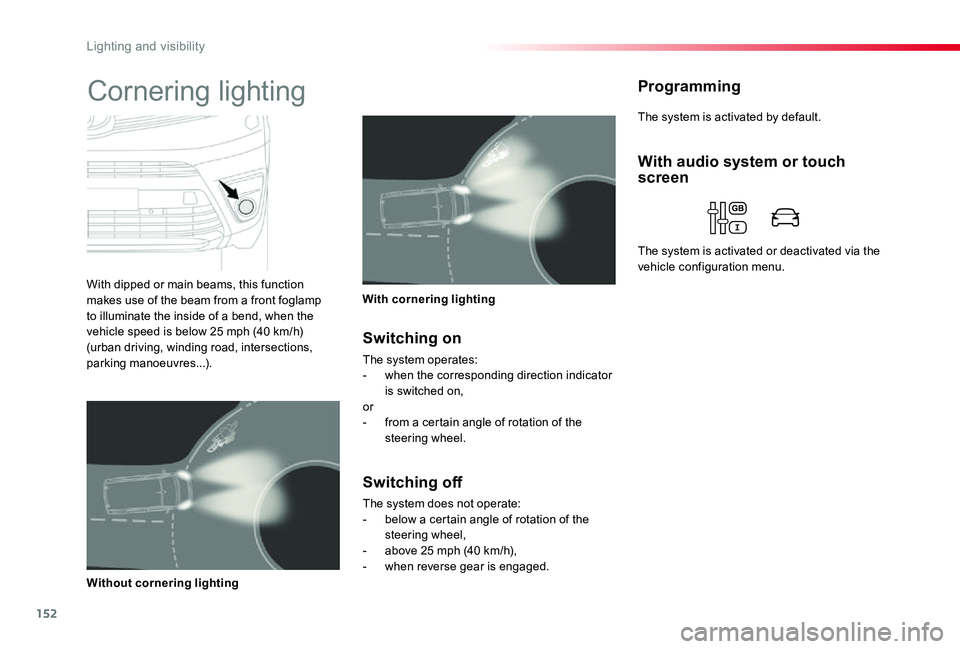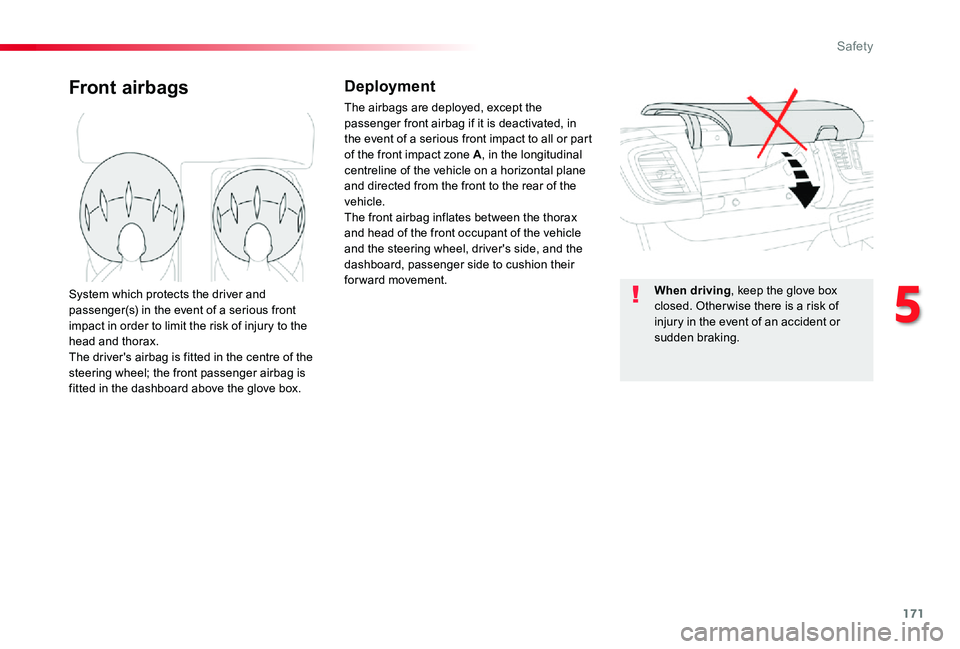steering wheel TOYOTA PROACE 2020 Owners Manual (in English)
[x] Cancel search | Manufacturer: TOYOTA, Model Year: 2020, Model line: PROACE, Model: TOYOTA PROACE 2020Pages: 430, PDF Size: 48.01 MB
Page 2 of 430

.
.
4
Over view
Instrument panels 14Indicator and warning lamps 17Engine coolant temperature 31Distance recorders 38Lighting dimmer 39Trip computer 40Touch screen 43Setting the date and time 46
Key 47Key, remote control 47Smart Entry & Start System 55Locking / unlocking from inside 72Front doors 74Manual sliding side door(s) 75Electric sliding side door(s) 78Kick-activated side doors openingand locking 87Rear wing doors with glass windows 91Rear tailgate 94Alarm 95Electric windows 98
Steering wheel adjustment 99Front seats 992-seat front bench seat 104Smart Cargo 10 6Fixed one-piece bench seat 110Fixed rear seat and bench seat 113Fixed crew cab 117Crew cab, folding 118Interior fittings 119Loading area fittings 122Seating area fittings 123Heating / Ventilation 125Manual air conditioning 126Dual-zone automatic air conditioning 128Front demist - defrost 132Door mirrors demist - defrost 133Rear screen demist - defrost 134Rear Heating - Air Conditioning 137Fuel burner heater / Remote controlledfuel burner heater 13 8Courtesy lamp(s) 141
Mir ror s 143Lighting control stalk 146Daytime running lamps 149Automatic illumination of headlamps 149Automatic headlamp dipping 153Manual headlamp beam height adjustment 155Wiper control stalk 156Automatic rain sensitive wipers 157
Hazard warning lamps 160ERA-GLONASS emergency call system 160Horn 161Electronic stability control (ESC) 161Toyota Traction Select 16 4Seat belts 166Airbags 170Child seats 174Deactivating the passenger front airbag 177ISOFIX mountings 186Manual child lock 194Electric child lock 194Child lock on rear windows 195
Eco-driving
Instruments
Access
Ease of use and comfortLighting and visibility
Safety
Labels 11
Contents
Page 7 of 430

7
Locking / unlocking from inside 72-73Electric sliding door(s) 78 - 86Cabin / loading area selectivity 47-48, 55Electric child lock 194Hazard warning lamps 160Reinitialising the Tyre Pressure Warning System (TPWS) 263 -264Deactivating Stop & Start 220Deactivating the DSC/ASR system 163
Adjusting the steering wheel 99Horn 161
Head-up display 222-223
Instruments and controls (cont.)
Wiper c ontrol 15 6 -159Trip computer 40 - 42
Memorising speeds 224Speed limiter 229-231Cruise control 232-235Dynamic cruise control 236 -242
Instrument panels 14-16Warning lamps 17-30Coolant temperature 31Service indicator 31-33Oil level indicator 34AdBlue® range indicator 35 -37Distance recorder 38Gear efficiency indicator 208Lighting dimmer 39Trip computer 40 - 42Setting the time and date 46Driver Attention Alert 250-251
Electric windows 98Adjusting the electric mirrors 143
Toyota Traction Select 163, 164-165Fuel burner heater / Remote controlled fuel burner heater 138 -140Alarm 95-97Manually adjusting the headlamp beam height 155Lane Departure Alert 248 -249Blind spot monitoring system 252-254Automatic headlamp dipping 153-154
Setting the time and date 46180º Rear vision 259 -261Adjustable Speed Limiter (ASL) 224Road Sign Assist 225 -228, 231, 234, 238Forward collision warning 243-245Autonomous emergency braking 243, 246 -249Deactivating Stop & Start 220
Lighting control 146-151Direction indicators 148
.
Over view
Page 40 of 430

40
System that gives you information on the current journey (range, fuel consumption…).
Trip computer
Display of information
F Press the button on the end of the wiper control stalk to display the different trip computer tabs in turn.
F Or, depending on equipment, press the thumbwheel on the steering wheel.
- The current information with:● the range,● the current fuel consumption,● the Stop & Start time counter.
Tr i p s "1" and "2" are independent but their use is identical.For example, trip "1" can be used for daily figures, and trip "2" for monthly figures.
- Trip "2" with:● the average speed,● the average fuel consumption,● the distance travelled, for the second trip.
- Trip "1" with:● the average speed,● the average fuel consumption,● the distance travelled, for the first trip.
Depending on equipment, a 2nd trip is available.
Instruments
Page 41 of 430

41
Trip reset
With LCD text instrument panel
F When the trip is displayed, press the button on the end of the wiper control stalk.
F Or, depending on equipment, press the thumbwheel on the steering wheel for more than two seconds.F When the desired trip is displayed, press the reset button in the instrument panel for more than two seconds.
With LCD text or matrix instrument panel
With LCD instrument panel
F When the trip is displayed, press the button on the end of the wiper control stalk for two seconds.
1
Instruments
Page 99 of 430

99
Steering wheel adjustment
F When stationary, lower the control lever to release the steering wheel adjustment mechanism.F Adjust the height and reach to suit your driving position.F Pull the control lever to lock the steering wheel adjustment mechanism.
As a safety precaution, these
operations should only be carried out while the vehicle is stationary.
Front seats with manual adjustments
F Raise the control and slide the seat forwards or backwards.F If fitted to your vehicle, pull the control upwards to raise or push it downwards to lower, as many times as required to obtain the position required.
Forwards-backwardsHeight
As a safety measure, seat adjustments should only be carried out when stationary.
Before moving the seat backwards, ensure that there is nothing that might prevent the full travel of the seat, so as to avoid the risk of jamming the seat caused by the presence of objects on the floor behind the seat or rear passengers. If the seat jams, stop the movement immediately.
For more information on the Seat belts, refer to the corresponding section.
3
Ease of use and comfort
Page 121 of 430

121
Upper storage compartment
This is located in the dashboard, behind the steering wheel.
Press the control to open the lid (depending on version) then guide it to its fully open position.To close, guide the lid then press the centre g e nt l y.Any liquid which could spill risks causing an electrical short circuit and therefore a potential fire.
12 V accessory socket(s)
(depending on version)
F To connect a 12 V accessory (maximum power: 120 Watts), lift the cover and connect a suitable adaptor.
Obser ve the maximum power rating to avoid damaging your accessory.
The connection of an electrical device not approved by Toyota, such as a USB charger, may adversely affect the operation of vehicle electrical systems, causing faults such as poor telephone reception or inter ference with displays
in the screens.
3
Ease of use and comfort
Page 152 of 430

152
ProgrammingCornering lighting
With dipped or main beams, this function makes use of the beam from a front foglamp to illuminate the inside of a bend, when the vehicle speed is below 25 mph (40 km/h) (urban driving, winding road, intersections, parking manoeuvres...).
With cornering lighting
Without cornering lighting
Switching on
The system operates:- when the corresponding direction indicator is switched on,or- from a certain angle of rotation of the steering wheel.
Switching off
The system does not operate:- below a certain angle of rotation of the steering wheel,- above 25 mph (40 km/h),- when reverse gear is engaged.
With audio system or touch screen
The system is activated or deactivated via the vehicle configuration menu.
The system is activated by default.
Lighting and visibility
Page 161 of 430

161
ER A - GLONASS
emergency call system*Electronic stability control (ESC) incorporating the following systems:- anti-lock braking system (ABS) and electronic brake force distribution (EBFD),- emergency braking assistance (EBA),- wheel anti-slip regulation (ASR) or traction control,- dynamic stability control (DSC).
Electronic stability control (ESC)
Definitions
Anti-lock braking system (ABS) and electronic brake force distribution (EBFD)
This system improves the stability and manoeuvrability of your vehicle when braking and contributes towards improved control on corners, in particular on poor or slippery road surfaces.The ABS prevents wheel lock in the event of emergency braking.The EBFD manages the braking pressure wheel by wheel.
Emergency braking assistance (EBA) / Brake assist
In an emergency, this system enables you to reach the optimum braking pressure more quickly and therefore reduce the stopping distance.It is triggered according to the speed at which the brake pedal is pressed. This is felt by a reduction in the resistance of the pedal and an increase in the effectiveness of the braking.
Anti-slip regulation (ASR) / Traction Control (TRC)
The ASR system (also known as Traction Control) optimises traction in order to limit wheel slip by acting on the brakes of the driving wheels and on the engine. It also improves the directional stability of the vehicle on acceleration.
Dynamic stability control (DSC) / Vehicle Stability Control (VSC)
If there is a difference between the path followed by the vehicle and that required by the driver, the DSC monitors each wheel and automatically acts on the brake of one or more
wheels and on the engine to return the vehicle to the required path, within the limits of the laws of physics.
Horn
F Press the central part of the steering wheel.
5
Safety
Page 171 of 430

171
Front airbagsDeployment
The airbags are deployed, except the passenger front airbag if it is deactivated, in the event of a serious front impact to all or part of the front impact zone A, in the longitudinal centreline of the vehicle on a horizontal plane and directed from the front to the rear of the vehicle.The front airbag inflates between the thorax and head of the front occupant of the vehicle
and the steering wheel, driver's side, and the dashboard, passenger side to cushion their for ward movement.System which protects the driver and passenger(s) in the event of a serious front impact in order to limit the risk of injury to the head and thorax.The driver's airbag is fitted in the centre of the steering wheel; the front passenger airbag is fitted in the dashboard above the glove box.
When driving, keep the glove box closed. Other wise there is a risk of injury in the event of an accident or sudden braking.
5
Safety
Page 173 of 430

173
Sit in a normal upright position.Wear a correctly adjusted seat belt.Do not leave anything between the occupants and the airbags (a child, pet, object...), nor fix or attach anything close to
the inflation trajectory of the airbags; this could cause injuries during their deployment.Never modify the original definition of your vehicle, particularly in the area directly around the airbags.After an accident or if the vehicle has been stolen or broken into, have the airbag systems checked.All work on the airbag system must be carried out by an authorized Toyota dealer or repairer, or another duly qualified and equipped professional.Even if all of the precautions mentioned are obser ved, a risk of injury or of minor burns to the head, chest or arms when an airbag is deployed cannot be ruled out.
Lateral airbags
Use only approved covers on the seats, compatible with the deployment the lateral airbags. For information on the range of seat covers suitable for your vehicle, you can contact an authorized Toyota dealer or repairer, or another duly qualified and equipped professional.For more information on Accessories, refer to the corresponding section.Do not fix or attach anything to the seat backs (clothing...). This could cause injury to the chest or arms if the lateral airbag is deployed.Do not sit with the upper part of the body any nearer to the door than necessary.
The bag inflates almost instantly (within a few milliseconds) then deflates within the same time discharging the hot gas via openings provided for this purpose.
Front airbags
Do not drive holding the steering wheel by its spokes or resting your hands on the centre part of the wheel.Passengers must not place their feet on the dashboard.Do not smoke as deployment of the airbags can cause burns or the risk of injury from a cigarette or pipe.Never remove or pierce the steering wheel or hit it violently.Do not fit or attach anything to the steering wheel or dashboard, this could cause injuries with deployment of the airbags.
Advice
For the airbags to be fully effective, observe the safety recommendations below:
The vehicle's front door panels include side impact sensors.A damaged door or any unauthorised or incorrectly executed work (modification or repair) on the front doors or their interior trim could compromise the operation of these sensors - Risk of malfunction of the lateral airbags!Such work must only be done by an authorized Toyota dealer or repairer, or another duly qualified and equipped professional.
5
Safety